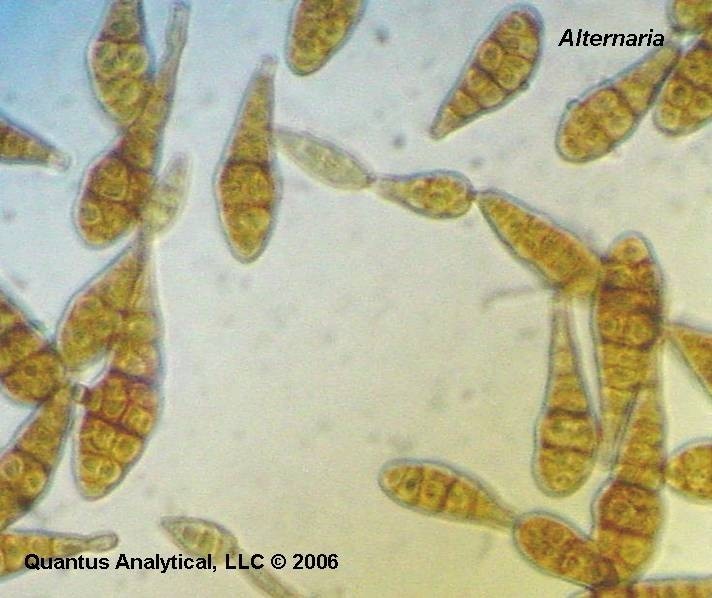
Airborne Mold Spores Increase Kids Risk for Multiple Allergies
CINCINNATIUniversity of Cincinnati (UC) researchers say exposure to a certain group of fungal sporesabundant in the air that we breathe every daycan make young children more susceptible to developing multiple allergies later in life.
The team found that infants who were exposed to basidiospores and other airborne fungal sporesspecifically penicillium/aspergillus and alternariaearly in life were more likely to develop allergies to mold, pollen, dust mites, pet dander and certain foods as they grew older.
This is the first study to show a relationship between specific airborne fungal spores and an increased risk for multiple allergies in children, the UC team reports in an upcoming edition of Pediatric Allergy and Immunology and an early online edition June 14.
A fungus is a plantlike organism that grows by releasing tiny reproductive cells (spores) into the air. Mold is a type of fungus that can grow on any moist surfaceincluding wood, drywall and cement.
Previous allergy studies focused on visible mold or total mold concentrations, not the identification of specific airborne fungal spores. The UC-led study showed that exposure to specific airborne fungal spores may increase allergic reactions and others could help reduce them.
These findings reinforce the idea that not all fungi are created equal, says Tiina Reponen, PhD, professor of environmental health at UC and corresponding author on the study.
It turns out that the health effects of airborne fungal spores are more complicated than we thought, she says. Its not enough to look just at total mold in our homes and offices. We need to understand how specific types of mold interact with each other in the environment to affect our respiratory health. Some fungi can have harmful effects on the body, but others may be beneficial.
There are literally thousands of different types of mold in the air we breathe, adds Melissa Osborne, a graduate of UCs environmental and occupational hygiene program and study lead author. But because mold exists naturally in the outdoors, its very difficult to completely remove mold spores from the air."
Osborne conducted this research while pursuing her masters at UC and is currently employed as an environmental consultant at Quantus Analytical, a mold and allergen laboratory and consulting group in Cincinnati.
Using a small air sampling device, the UC research team collected fungal spores from the homes of 144 infants enrolled in the Cincinnati Childhood Allergy and Air Pollution Study (CCAAPS).
The CCAAPS, funded by the National Institute of Environmental Health Sciences, is a five-year study examining the effects of environmental particulates on childhood respiratory health and allergy development.
Air samples were collected for a total of 48 hours in the childs primary activity room and in the childs bedroom during sleep. Samples were analyzed for both total and individual spore counts.
We found that, at least in children, some fungi may cause allergic sensitization while other fungal types may actually inhibit the development of allergies, explains Osborne.
But very little is known about how infant allergies to environmental allergens develop, she adds, and more research is needed before we will fully understand the impact of fungi as an allergen in infants.
If mold is found in the home, the UC team recommends following the Environmental Protection Agency (EPA)-accepted guidelines for removing it. They also say any moisture issues, such as roof or plumbing leaks, should be resolved immediately to avoid mold development. Additional information on household mold issues can be found at www.epa.gov/moldresources.html.
Collaborators in this study include UCs Atin Adhikari, PhD, Sergey Grinshpun, PhD, Linda Levin, PhD, David Bernstein, MD, and Grace LeMasters, PhD, principal investigator of the CCAAPS and Seung-Hyun Cho, PhD, of the EPA.

This is a magnified view of penicillium, an airborne fungal spore.

Environmental health scientist Yulia Iossifova calibrates an air sampling device used to collect fungal spores.

Tiina Reponen, PhD, professor of environmental health, and student Yulia Iossifova examine air sampling equipment prior to collecting fungal spores.
Tags
Related Stories
Managing outpatient challenges for hypertensive intracerebral...
July 23, 2025
The University of Cincinnati Gardner Neuroscience Institute's Yasmin Aziz, MD, was featured in a MedCentral article discussing the challenges of managing hypertensive intracerebral hemorrhage in outpatient settings.
Donors drive record-breaking support for UC and UC Health
July 22, 2025
Generous donors have propelled the University of Cincinnati and UC Health to a historic fundraising year, contributing an unprecedented $228,479,079 in support.
UC students help to organize weekend medical clinic held at...
July 21, 2025
Thanks to a collaborative effort among Remote Area Medical Volunteers Corps, the University of Cincinnati's student chapter of RAM and Anthem Blue Cross and Blue Shield, Tristate residents had access to free medical care this weekend — no questions asked.
